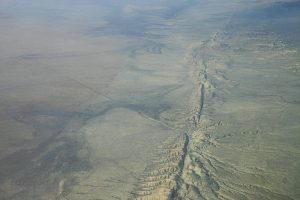
Seismologists working along California’s San Andreas Fault near Cholame and Parkfield now have a better idea of how and where friction changes along the fault to produce both shallow earthquakes and the deeper earth tremors called low-frequency earthquakes (LFEs).
In their report published online 26 January in the Bulletin of the Seismological Society of America (BSSA), the team led by Rebecca Harrington of McGill University shows that the depth of this boundary between earthquakes and LFEs varies along the San Andreas strike, but roughly follows along a zone deep in the crust where temperatures hover around 350 degrees Celsius.
There is also a somewhat puzzling, five-kilometer wide gap of seismic quiet between the deepest earthquakes and the shallowest LFEs analyzed in the study, the researchers noted. If this gap holds up under further scrutiny, seismologists will study its possible role in transferring seismic stress during a large earthquake, said Harrington.
Slip along the San Andreas occurs through either aseismic creep or earthquakes in the shallow parts of the fault (less than 15 kilometers deep) while slip takes the form of stable sliding in the deeper part of the fault lying 35 kilometers below the surface. The zone between these two regions–where LFEs occur–is called the brittle-ductile transition zone, where increasing heat and pressure cause rocks to become less prone to fracture and more prone to bending and flowing deformation.
“Our study illuminates a possible gap in activity at the top of the transition zone, between the deeper LFEs and shallower earthquakes, which may be important to the transfer of stress into the seismogenic part of the fault,” Harrington noted. “We need to better understand how slip evolves across this boundary throughout the seismic cycle.”
Cholame may be best known as the site where iconic actor James Dean died in a 1955 car crash, but the Cholame section of the San Andreas Fault is also where the last major Southern California earthquake on the fault may have originated. The 1857 Fort Tejon earthquake measured magnitude 7.8, causing the fault to rupture the earth continuously for over 350 kilometers (225 miles).
Harrington and her colleagues deployed a temporary network of 13 seismic stations near Cholame to look more closely at the relationship between LFEs and earthquakes, since the area has been the site of vigorous LFE and tremor activity. Analyzing data collected by the temporary network and other permanent seismic stations, the scientists were able to precisely locate 34 earthquakes and 34 LFEs that occurred in the area between May 2010 and July 2011.
The depth at which fault slip changes from earthquake to LFE varies along the strike of the fault, they concluded. These variations could be caused by differences in the type of rock, the presence of fluids or other factors that affect the frictional properties of the fault along its strike.
In their analysis, the seismologists also identified two clusters of small earthquakes, one near the 2004 magnitude 6.0 Parkfield earthquake and one near the northern boundary of the Fort Tejon rupture, just south of Cholame. These clusters may represent areas of mixed frictional properties along the fault, adding support to the idea that earthquakes may originate in these types of frictional environments.
As for the mysterious gap separating earthquakes and LFEs, Harrington said it’s puzzling why there wouldn’t be more of a gradual transition between the two types of events as the fault deepens. One possibility, she says, is that the slip is aseismic in this zone. It might also be that the gap is accumulating strain, and won’t show signs of seismic slip until the strain rates are higher.
Harrington and her colleagues are working on further studies that could help detect more different types of LFEs, and to determine whether the gap is a real one, she said.
Note: The above post is reprinted from materials provided by Seismological Society of America.










